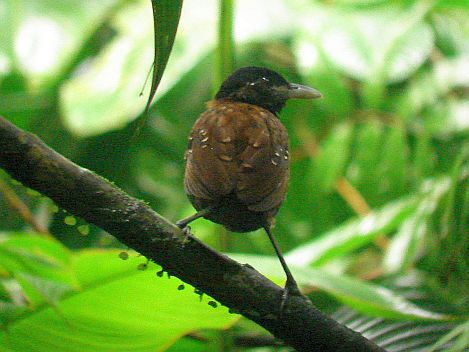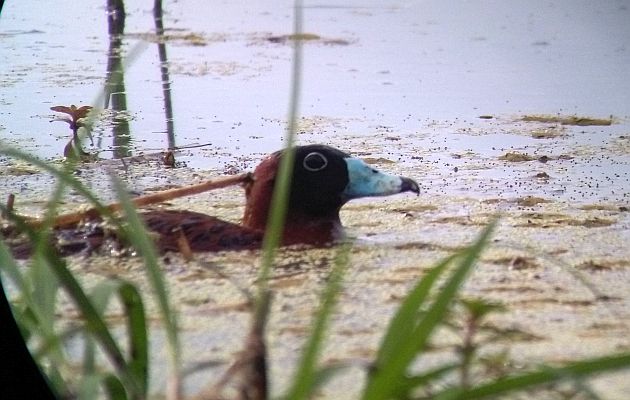What makes a bird rare? Is it because, like the Red-cockaded Woodpecker or Aquatic Warbler, it is threatened by various factors related to its ecological needs? Is a bird naturally rare because it requires certain types of uncommon habitats or situations? Or, is the species something like a Boreal Owl in not being really threatened but just hard to see?
In complex tropical habitats, birds can be “rare” because of these and additional factors. In the case of the Black-crowned Antpitta, this big understory player is probably affected by all three of the factors mentioned above. Hard to detect, difficult to see, we don’t know much about this northernmost Pittasoma but what we do know is that it’s one of the most challenging species to connect with in Costa Rica.

During birding tours to Costa Rica, this cool looking species has the tragic distinction of being one of the least likely birds you will run across. In part, the paucity of sightings is related to few tours actually visiting places where it occurs. However, even then, it can still be a challenge and worse, it seems to be getting rarer with each and every year.
This wasn’t always the case. Although, seeing a BC Pittasoma in Costa Rica has never really been easy, some years ago, it was petty reliable at Quebrada Gonzalez. When the foothill rainforest at this excellent site was perpetually dripping wet, this Pittasoma was regularly heard and seen. At one point, I recall hearing and seeing birds right behind the station and at two different points along the trail. Incredibly, it was a regular bird at this site! You still had to know how to look for it but it could be expected.

That began to change as the forest became hotter and drier. Bit by bit, as the forest at the beautiful forests of Quebrada Gonalez saw longer days with less rain and decreased humidity, there seemed to be a concurrent decrease in the numbers and types of birds. One of the most affected species was the Pittasoma. It still seems to occur on occasion but much much less than in the past.
With that in mind, this is my take on why this mega bird of the forest floor has become much more rare in Costa Rica:
It Needs an Especially Wet Microhabitat in Areas of Intact Habitat
The Black-crowned Antpitta seems to be a bird of very wet forest replete with plenty of streams and muddy, wet soil. At least that’s my impression and those are the only places I have encountered them. I suspect they are adapted to this type of microhabitat because it harbors more of the worms, large insects, and other small animals they feed on. Perhaps there are other factors associateed with this microhabitat they also require?
But that’s not all! It seems that they also need this microhabitat to occur in large areas of intact habitat and even then, they can seem to be absent from what appear to be suitable sites (which hints at this species maybe requiring more specific needs than expected or apparent).
The Pittasoma Mostly Occurs in Less Accessible Places or Does Best in Habitats that Have Beeen Destroyed
The bird is rare but I do think inaccessible areas are part of the situation. Most of the intact foothill forests where it occurs are in less accessible spots, especially in the Talamanca Mountains, its likely stronghold in Costa Rica. Another idea is that the bird might be most suited to the places where foothill forest meet lowland rainforest; places that have been largely destroyed. This idea is supported by more observations of the Pittasoma coming from sites like Hitoy Cerere and Kekoldi.
Additional places to look for it are in Barbilla National Park and less accessible spots in and near Braulio Carrillo National Park.
Top of the Understory Food Chain = Low Reproductive Rate
One of the other main factors that make this species such a rare bird is its likely low reproductive rate. That’s just a guess but given its status near the top of the forest floor avian food chain, I bet this is true. As with many other tropical birds, it may have a long lifespan over which rather few young are successfully raised. This adds up to there being few birds to find over a large area.
Hopefully, we can find more accessible sites to see this spectacular bird of wet forest. Sadly, I fear that if/as climate change continues to decrease rainfall and humidity in foothill forests of Costa Rica, the Black-crowned Antpitta will either move upslope or it will continue to decline and maybe even disappear. Populations also occur in Panama (although birds typically seen are of another subspecies) but if the same factors affect the species there, it could become one more of many amazing facets of life eventually obliterated by a long, lethal combination of greed, ignorance, and refusal to accept that long-term sustainable living is of crucial importance.










